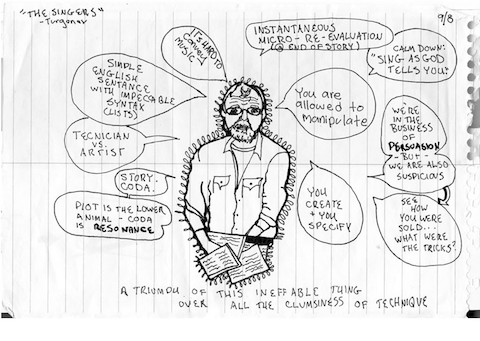Click for larger image
We’ve seen plenty of post-modern decay in writers before George Saunders—in Don DeLillo, J.G. Ballard—but never has it been filled with such puckish warmth, such whimsical detail, and such empathy, to use a word Saunders prizes. As a writer, Saunders draws readers in close to a very human world, albeit a fragmented, burned out, and frayed one, and it seems that he does so as a teacher as well. Since 1997, Saunders has taught creative writing at Syracuse University, where he received his M.A. in 1988, and where he remains, despite being awarded a MacArthur “Genius” Fellowship in 2006 and publishing steadily throughout the last decade and a half. To sit in a class with Saunders, according to his onetime student Rebecca Fishow, is to visit with a daring practitioner of the short form, one whose “words seem a lot like the transfer of secrets through a chain-link of writers.”
While attending one of Saunders’ semester-length writing seminars, writer and artist Fishow compiled the notes and sketches you see here (and several more at The Believer’s Logger site). In each sketch, Saunders teaches from one of his favorite classic Russian short story writers. At the top, see him expound on Turgenev’s method, proffering epiphanies, keen observations on craft, and writerly advice in word bubbles—“You are allowed to manipulate,” “Tecnician vs. Artist” [sic], “Instantaneous micro-re-evaluation (@end of story)”—while surrounded by a fringy aura. Above, Fishow reconstructs Saunders’ take on Chekhov’s “Lady with the Pet Dog” around a portrait of a pensive Saunders (looking a bit like Chekhov).
Fishow’s reconstructions are obviously very partial, and it’s not clear if she took them down on the spot or scribbled from memory (the misspellings make me think the former). In the sketch above, Saunders’ explicates Gogol, with phrases like “VERBAL JOY!” and an Einstein quote: “No worthy problem is ever solved on the plane of its original conception.” The latter is an interesting moment of Saunders’ scientific background slipping into his pedagogy. Before he was a MacAurthur winner and an enthusiastic teacher, Saunders worked as an environmental engineer. Of his science background, he has said:
…any claim I might make to originality in my fiction is really just the result of this odd background: basically, just me working inefficiently, with flawed tools, in a mode I don’t have sufficient background to really understand. Like if you put a welder to designing dresses.
As a teacher, at least in Fishow’s notes, Saunders celebrates “working inefficiently.” As she puts it: “His wisdom confirms that flaw and uncertainty and variety and empathy (especially empathy) are positive aspects of the writing process.” Fishow’s portraits go a long way toward conveying those qualities in Saunders as a presence in the classroom.
Find more sketches at The Believer’s Logger site.
Also Read 10 Free Stories by George Saunders Online.
Related Content:
George Saunders Extols the Virtues of Kindness in 2013 Speech to Syracuse University Grads
Vladimir Nabokov (Channelled by Christopher Plummer) Teaches Kafka at Cornell
James Joyce, With His Eyesight Failing, Draws a Sketch of Leopold Bloom (1926)
Josh Jones is a writer and musician based in Durham, NC. Follow him at @jdmagness





Leave a Reply